Differentiation Study of the Damage Characteristics of Rock Cultural Heritage Sites Due to the Sulfate Weathering Process
Abstract
:1. Introduction
2. Experimental Design
2.1. Preparation of Test Samples and Determination of Physical Properties
2.2. Experimental Methods
2.3. Mechanisms of Sulfate Weathering Damage
3. Experimental Results
3.1. Macroscopic Weathering Indicators
3.1.1. Apparent Morphology
3.1.2. Mass Loss
- In the initial stage of the experiment, the mass of sandstone increased due to two main factors. Firstly, the fresh sandstone had a relatively large initial porosity, allowing the crystallites formed by salt weathering to accumulate in the surface pores and fractures of the rock. This resulted in only minor damage within five cycles. Secondly, the crystallites generated during the cycling process block the throats of the pores and fractures, creating liquid-filled voids. This led to an increase in the water content inside the rock sample [25,26].
- On the other hand, limestone has a high initial density and small pores. As a result, even a small amount of salt crystallization can cause a reduction in mass.
- In the later stage of salt weathering, after 25 cycles within the experiment, the destructive effects of salt weathering gradually intensified, resulting in a continuous decrease in the mass of the rock samples as the number of cycles increased.
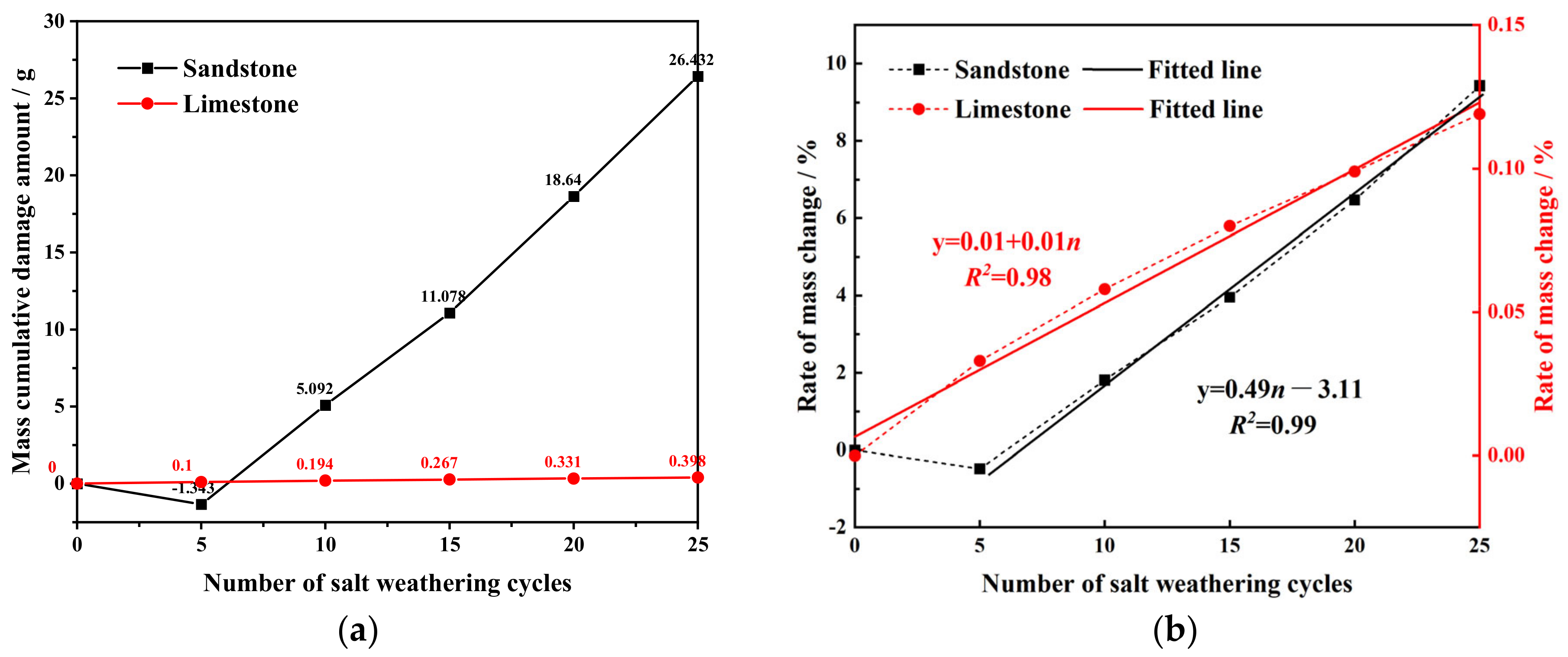
3.1.3. Surface Hardness
3.1.4. P-Wave Velocity
3.1.5. Uniaxial Compressive Strength
- (1)
- Characteristics of Uniaxial Compression Failure
- For the rock samples subjected to cycles 1 to 15, the predominant failure modes are brittle and tensile failure. The axial force compresses the fractures within the rock sample and expands its volume, resulting in a relatively intact middle portion, while the remaining parts fracture into multiple small pieces. The overall integrity of the rock sample is poor.
- At cycles 15 and 20, the bonding between particles weakens, leading to the emergence of multiple vertical cracks that penetrate the rock sample.
- By cycle 25, the surface layer of the rock has completely softened, and a large number of cracks appear within the rock sample. Applying minimal pressure causes vertical cracks to form at the sides, resulting in sample failure. Despite this, the rock sample still maintains a relatively intact overall appearance, reflecting the softening and plasticity of sandstone after prolonged salt weathering.
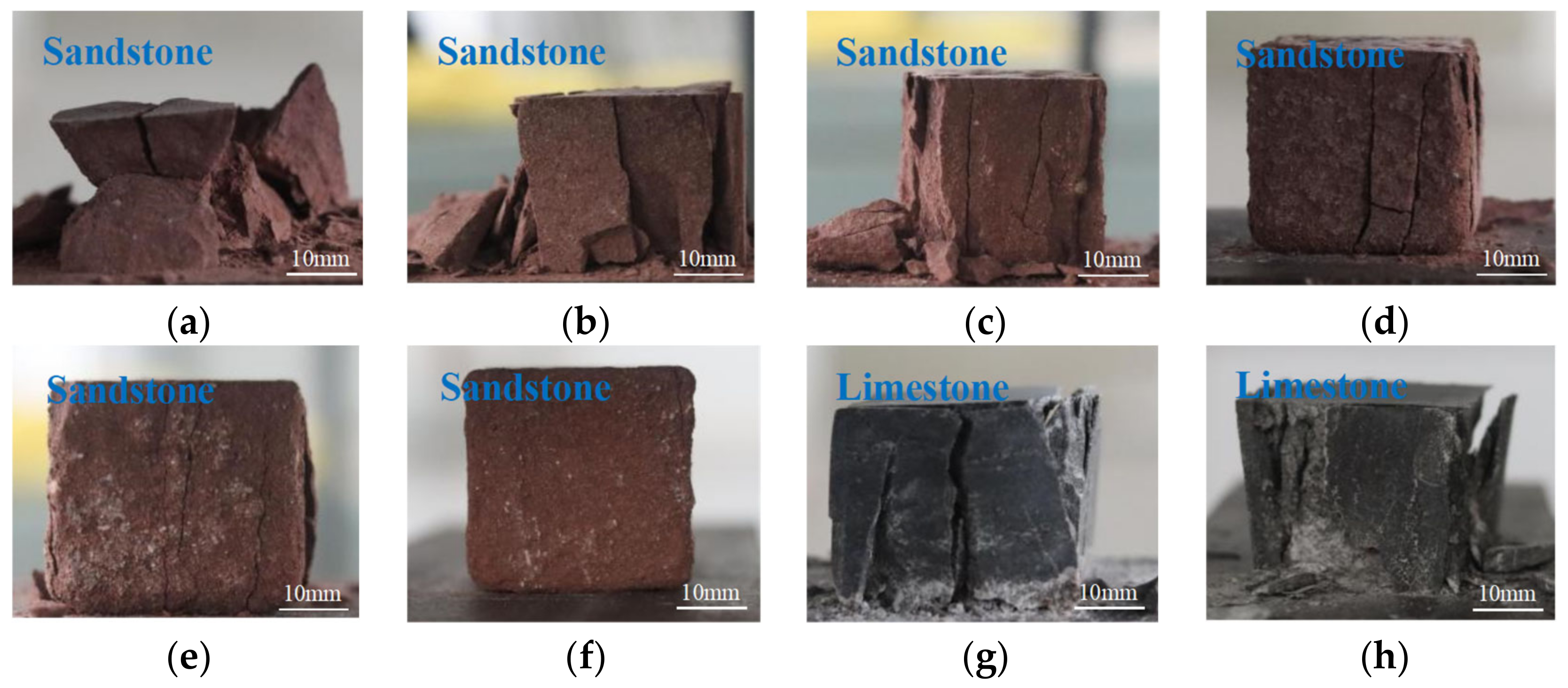
- (2)
- Uniaxial Compressive Strength
3.2. Microscopic Weathering Indicators
3.2.1. Variation of Composition Change Law
3.2.2. Pore Size Distribution Characteristics
4. Discussion and Analysis
4.1. Exploration of the Correlation between Pore Characteristics and Macroscopic Indicators
4.2. Analysis of the Differential Sensitivity of Macroscopic Indicators to Sulfate Erosion in Sandstone and Limestone
5. Conclusions
- (1)
- Under sulfate erosion, the sandstone samples exhibited notable surface damage, including particle detachment, edge dulling, and increased crack and fissure width. The deterioration process occurred from top to bottom and from outer to inner layers. In contrast, the limestone sample showed only salt efflorescence on the surface, with minor damage to the edges and less noticeable changes in other areas. Some common characteristics of damage to rock cultural heritage sites under the influence of sulfate surface weathering include salt efflorescence, powder-like and flocculent detachment, and cracking.
- (2)
- The macroscopic indicators of both rock types, such as mass, wave velocity, and compressive strength, decreased to varying degrees, with sandstone deteriorating at a much faster rate than limestone. The number of cycles affecting both rock samples could be fitted with linear or exponential functions for wave velocity and compressive strength, but notable differences existed in their trends of change. The combined effects of the rock lithology and sulfate damage mechanism led to a gradual decrease in the calcite content and an increase in the dolomite content in the limestone sample. Additionally, the number of pores larger than 100 μm distinctly increased. In the sandstone sample, there was an obvious decrease in the content of calcite and feldspar minerals, a decrease in the number of pores smaller than 10 μm, and a significant increase in the number of pores larger than 14 μm.
- (3)
- Sulfate weathering induced physical and chemical reactions that accumulated microstructural damage in the surface layer of the rock samples, resulting in visible instantaneous macroscopic damage and a series of changes in macroscopic indicators, such as reduced mass, decreased wave velocity, and weakened strength. The pore damage factor of sandstone was approximately 2–4 times higher than that of limestone. The pore damage factors of both rock types could be fitted with exponential (y = ae(x/b) + c), exponential (y = a + b/(1 + e(x−c)/d), and linear (y = ax + b) functions for wave velocity, surface hardness, and compressive strength, respectively (where a, b, c and d are constants). However, there were notable differences in the magnitude and rate of change.
- (4)
- The entropy weight–TOPSIS method was used to comprehensively evaluate the rock damage state by normalizing multiple indicators, assigning weights to different weathering indicators, and calculating the relative proximity to the distance between the best and worst solutions for each indicator. The weight factor for mass loss was the highest in the sandstone sample, while the porosity of the limestone sample reflected a sensitivity to sulfate erosion. Overall, the sandstone exhibited a fast–slow change trend in its overall damage level, while limestone exhibited a slow–fast decay trend.
Author Contributions
Funding
Institutional Review Board Statement
Informed Consent Statement
Data Availability Statement
Conflicts of Interest
References
- Liu, J.C.; Xiao, L.Z.; Xie, Z.B. Protection of stone cultural relics in China: Analysis of NSFC-funded projects. Sci. Conserv. Archaeol. 2019, 31, 112–119. [Google Scholar]
- Yi, Y.; Chen, Y. An Analysis of the Statistics on Major Historical and Cultural Sites Protected at the National Level. Southeast Cult. 2021, 4, 6–15. [Google Scholar]
- Wang, J.H.; Chen, J.Q. Current Status and Future Development of Cave Temples Protection in China. Southeast Cult. 2018, 1, 6–14 + 127–128. [Google Scholar]
- Steiger, M.; Asmussen, S. Crystallization of sodium sulfate phases in porous materials: The phase diagram Na2SO4·H2O and the generation of stress. Geochim. Cosmochim. Acta 2008, 72, 4291–4306. [Google Scholar] [CrossRef]
- Oguchi, C.T.; Yu, S. A review of theoretical salt weathering studies for stone heritage. Prog. Earth Planet. Sci. 2021, 8, 32–55. [Google Scholar] [CrossRef]
- Holynska, B.; Gilewicz-Wolter, J.; Ostachowicz, B.; Bielewski, M.; Streli, C.; Wobrauschek, P. Study of the deterioration of sandstone due to acid rain and humid SO2 gas. X-Ray Spectrom. 2010, 33, 342–348. [Google Scholar] [CrossRef]
- Behlen, A.; Steiger, M.; Dannecker, W. Deposition of sulfur dioxide to building stones: The influence of the ambient concentration on the deposition velocity. Environ. Geol. 2008, 56, 595–603. [Google Scholar] [CrossRef]
- Ruiz-Agudo, E.; Mees, F.; Jacobs, P.; Rodriguez-Navarro, C. The role of saline solution properties on porous limestone salt weathering by magnesium and sodium sulfates. Environ. Geol. 2007, 52, 269–281. [Google Scholar] [CrossRef]
- Li, L.; Wang, S.J.; Tanimoto, C. Study of weathering characteristics of sandstone at longyou grottoes. Chin. J. Rock Mech. Eng. 2008, 6, 1217–1222. [Google Scholar]
- Martinez, M.; Benavente, D.; Garcia, M. Spatial attenuation: The most sensitive ultrasonic parameter for detecting petrographic features and decay processes in carbonate rocks. Eng. Geol. 2011, 119, 84–95. [Google Scholar] [CrossRef]
- Theoulakis, P.; Moropoulou, A. Microstructural and mechanical parameters determining the susceptibility of porous building stones to salt decay. Constr. Build. Mater. 1997, 11, 65–71. [Google Scholar] [CrossRef]
- Wilhelm, K.; Viles, H.; Burke, O.; Mayaud, J. Surface hardness as a proxy for weathering behaviour of limestone heritage: A case study on dated headstones on the Isle of Portland, UK. Environ. Earth Sci. 2016, 75, 931–947. [Google Scholar] [CrossRef]
- Riontino, C.; Sabbioni, C.; Ghedini, N.; Zappiaa, G.; Gobbi, G.; Favoni, O. Evaluation of atmospheric deposition on historic buildings by combined thermal analysis and combustion techniques. Thermochim. Acta 1998, 321, 215–222. [Google Scholar] [CrossRef]
- Angeli, M.; Bigas, J.-P.; Benavente, D.; Menéndez, B.; Hébert, R.; David, C. Salt crystallization in pores: Quantification and estimation of damage. Environ. Geol. 2007, 52, 205–213. [Google Scholar] [CrossRef]
- Yan, S.J.; Fang, Y.; Liu, J.H.; Tan, S.E. Deterioration experiment with soluble salt on sandstone of Yungang grottoes and its model creation. Rock Soil Mech. 2013, 34, 3410–3416. [Google Scholar]
- Zhang, L.; Wang, Y.; Zhang, J.; Zhang, S.; Guo, Q. Rockfall hazard assessment of the slope of Mogao Grottoes, China based on AHP, F-AHP and AHP-TOPSIS. Environ. Earth Sci. 2022, 81, 377. [Google Scholar] [CrossRef]
- Yao, X.; Sun, M.L. The Quantitative Evaluation of Deterioration Degrees of Earthen Sites Based on Gray Correlation Analysis. Dunhuang Res. 2016, 128–134. [Google Scholar]
- Lan, H.X.; Lv, H.T.; Bao, H.; Li, L.; Chne, W.; Guo, J.; Liu, S. Advances in Degradation and Instability Mechanism of Grotto Temple Rock Mass. Earth Sci. 2023, 48, 1603–1633. [Google Scholar]
- Guo, F.; Jiang, G.H. Investigation into rock moisture and salinity regimes: Implications of sandstone weathering in Yungang Grottoes, China. Carbonates Evaporites 2015, 30, 1–11. [Google Scholar] [CrossRef]
- Lu, H.; Fu, W.L.; Chai, J.; Liu, S.; Sun, Z. Analysis of Sandstone in Leshan Giant Buhhda Based on Hand-Held X-ray Fluorescence Spectrometer. Spectrosc. Spectr. Anal. 2022, 42, 2506–2512. [Google Scholar]
- Ministry of Land and Resources, People’s Republic of China. GZ/T 0276.1-2015; Test Rules for Rock Physical Properties. Standards Press of China: Beijing, China, 2015.
- Wang, Y.; Viles, H.; Desarnaud, J.; Yang, S.; Guo, Q. Laboratory simulation of salt weathering under moderate ageing conditions: Implications for the deterioration of sandstone heritage in temperate climates. Earth Surf. Process. Landf. 2021, 46, 1055–1066. [Google Scholar] [CrossRef]
- Andrea, H.; Robert, I.M. Raman spectra of mirabilite, Na2SO4·10H2O and the rediscovered metastable heptahydrate, Na2SO4·7H2O. J. Raman Spectrosc. 2010, 41, 1014–1020. [Google Scholar]
- Sun, M.L.; Liang, C.X.; Shen, Y.X.; Shang, X.J.; Cao, Z.J. Characteristics of salt damage to sandstone grottoes in Northwest China and contributing factors. J. Earth Environ. 2022, 13, 543–556. [Google Scholar]
- Sun, D.; Zhou, Q.; Sun, W. Effect of Sulfate Crystallization on Sandstone in the Yungang Grottoes. Res. Sq. 2021, 1, 1–24. [Google Scholar]
- Wang, F.R.; Jiao, D.; Liu, P.; Sun, B.; Wang, J.J.; Yang, H.R. Experimental study on the effect of sulfate on glutenite weathering in Maijishan grottoes. Rock Soil Mech. 2020, 41, 2199–2206. [Google Scholar]
- Lee, J.S.; Yoon, H.K. Characterization of rock weathering using elastic waves: A Laboratory-scale experimental study. J. Appl. Geophys. 2017, 140, 24–33. [Google Scholar] [CrossRef]
- Zhang, J.; Huang, J.; Liu, J.; Jiang, S.; Li, L.; Shao, M. Surface weathering characteristics and degree of Niche of Sakyamuni Entering Nirvana at Dazu Rock Carvings, China. Bull. Eng. Geol. Environ. 2018, 78, 3891–3899. [Google Scholar] [CrossRef]
- Ma, T.; Ding, W.X.; Wang, H.Y.; Chen, G.X.; Chen, H.J.; Yan, Y.Y. Dissolution characteristics and mechanical properties of limestone with different mineral composition contents eroded by acid chemical solution. Chin. J. Geotech. Eng. 2021, 43, 1550–1557. [Google Scholar]
- Chen, W.-C.; Li, L.; Shao, M.-S.; Liang, X.-Z.; Lekan Olatayo, A. Experimental study on carbonate dissolution and erosion effect under attack of simulated sulphuric acid rain. Chin. J. Geotech. Eng. 2017, 39, 2058–2067. [Google Scholar]
- Ge, X.-B.; Li, J.-J.; Lu, S.-F.; Chen, F.-W.; Yang, D.-X.; Wang, Q. Fractal characteristics of tight sandstone reservoir using mercury intrusion capillary pressure—A case of tight sandstone reservoir in Jizhong Depression. Lithol. Reserv. 2017, 29, 106–112. [Google Scholar]
- Hebib, R.; Belhai, D.; Alloul, B. Estimation of uniaxial compressive strength of North Algeria sedimentary rocks using density, porosity, and Schmidt hardness. Arab. J. Geosci. 2017, 10, 383–396. [Google Scholar] [CrossRef]
- Katz, O.; Reches, Z.; Roegiers, J.C. Evaluation of mechanical rock properties using a Schmidt Hammer. Int. J. Rock Mech. Min. Sci. 2000, 37, 723–728. [Google Scholar] [CrossRef]
- Ding, W.X.; Feng, X.T. Study on chemical damage effect and quantitative analysis method of meso-structure of limestone. Chin. J. Rock Mech. Eng. 2005, 24, 1283. [Google Scholar]
- Wang, N.; Zhao, X.; Wang, L.; Zou, Z. Novel System for Rapid Investigation and Damage Detection in Cultural Heritage Conservation Based on Deep Learning. J. Infrastruct. Syst. 2019, 25, 04019020. [Google Scholar] [CrossRef]
- Yang, J.C.; Zhao, C. Survey on K-Means Clustering Algorithm. Comput. Eng. Appl. 2019, 55, 7–14+63. [Google Scholar]
- Jordan, M.I.; Mitchell, T.M. Machine learning: Trends, perspectives, and prospects. Science 2015, 349, 255–260. [Google Scholar] [CrossRef]
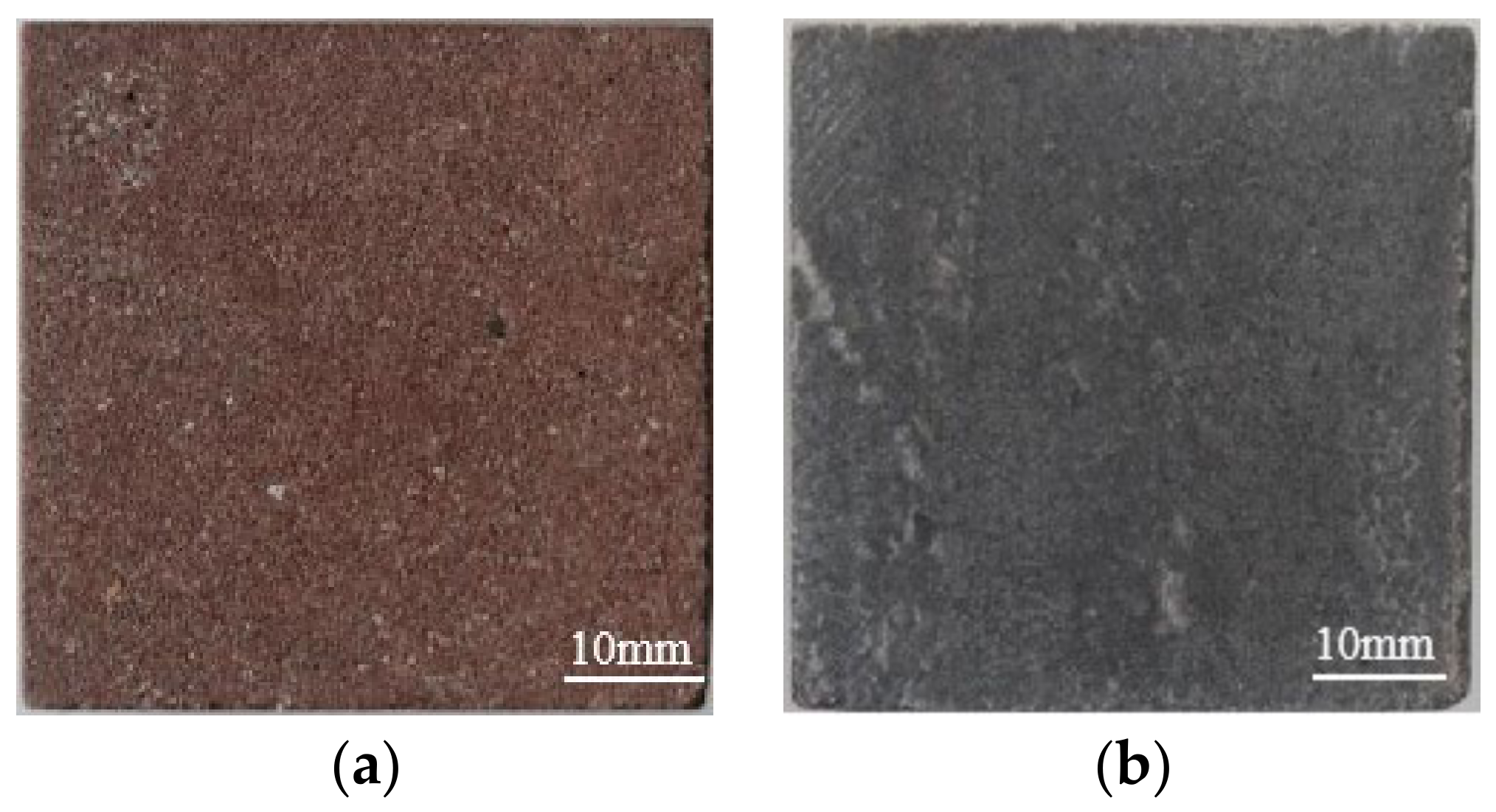






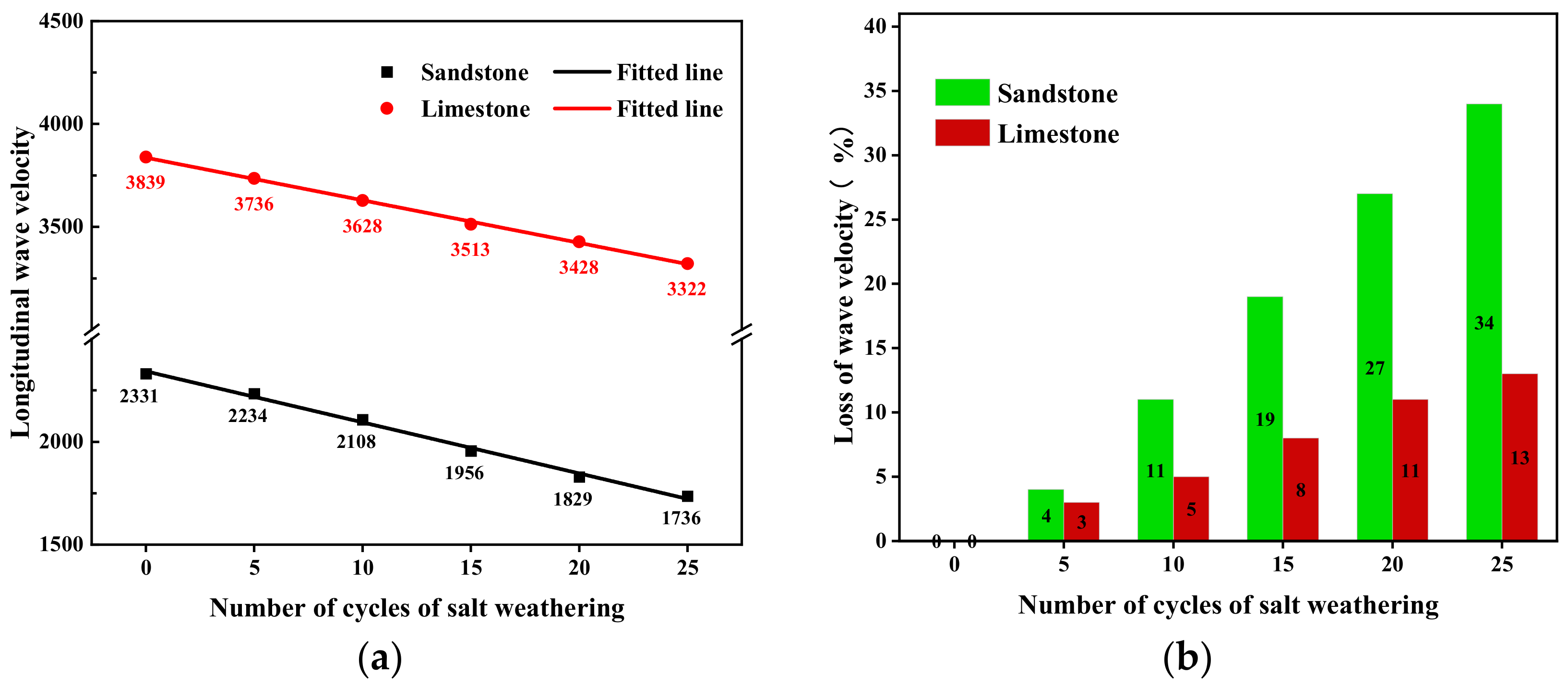
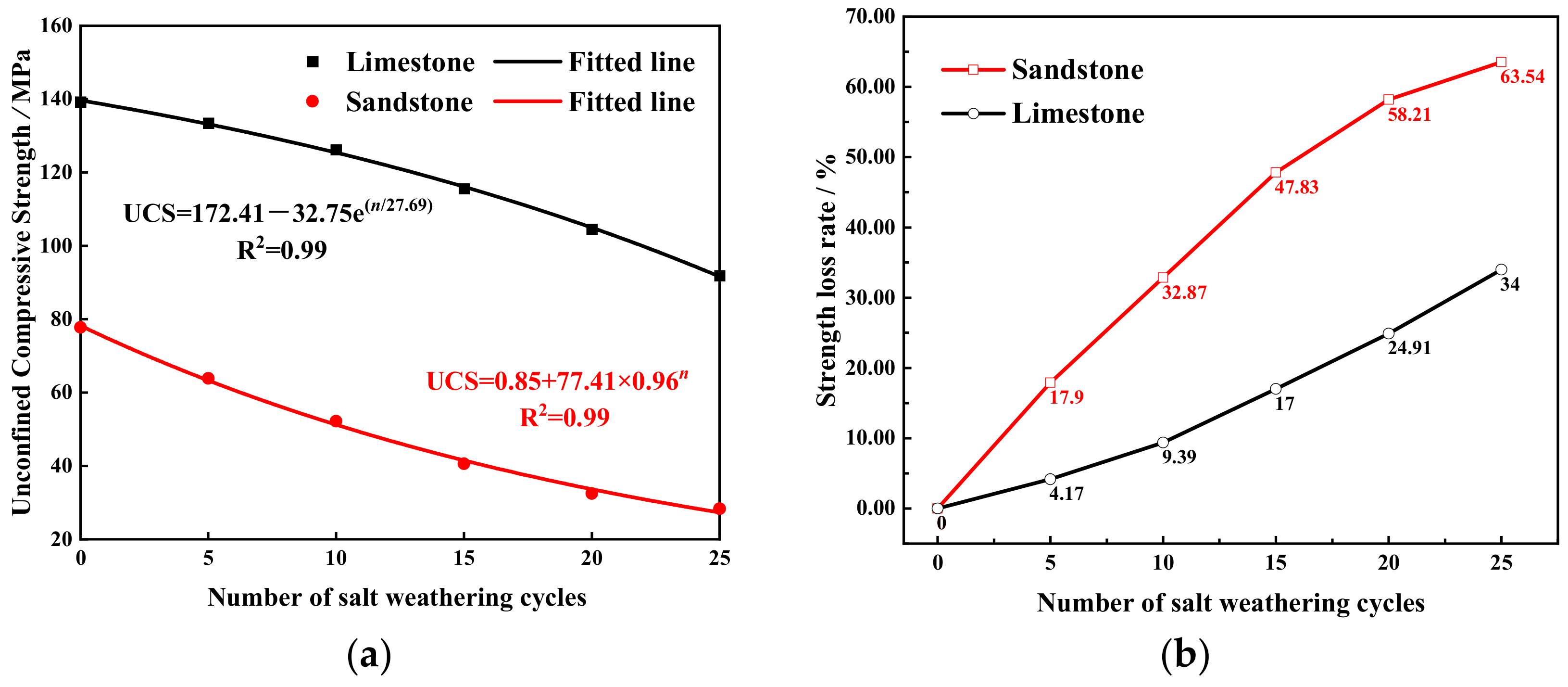
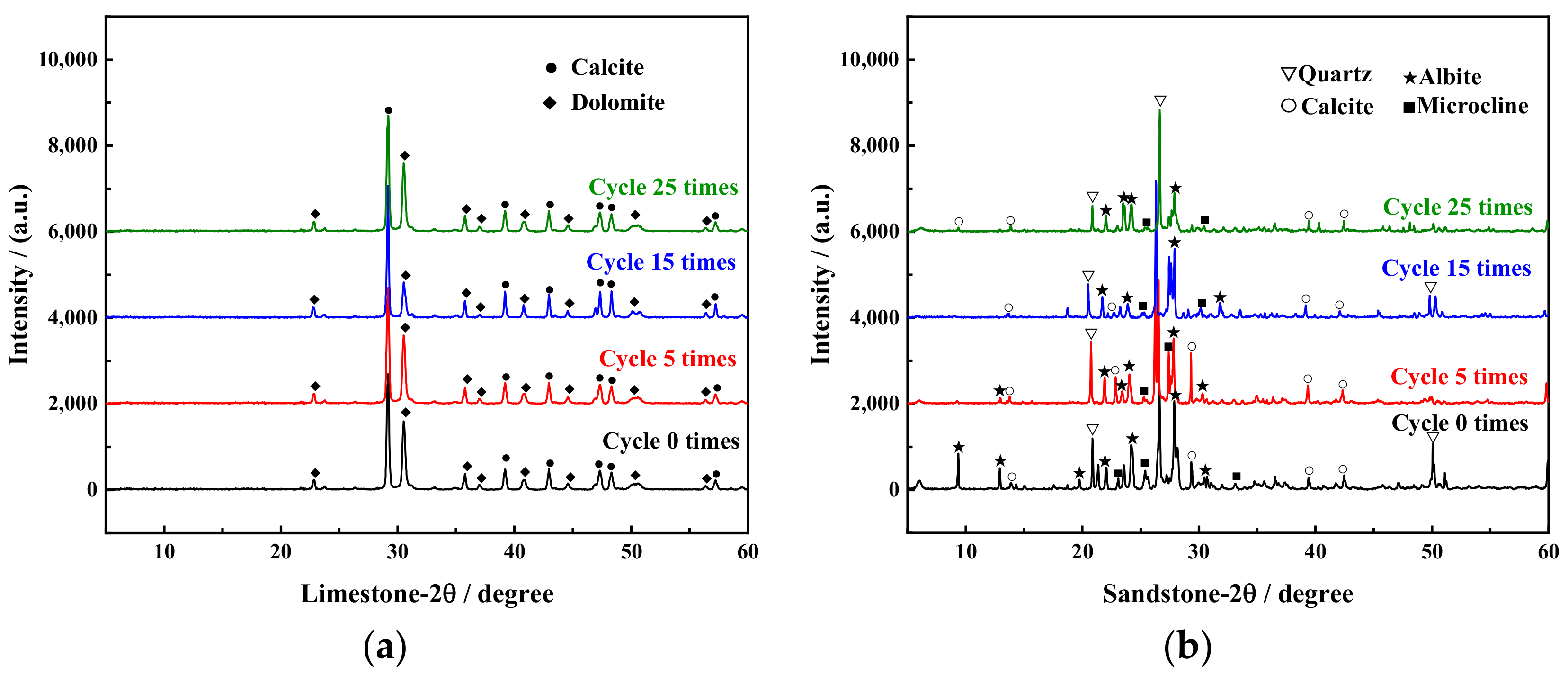
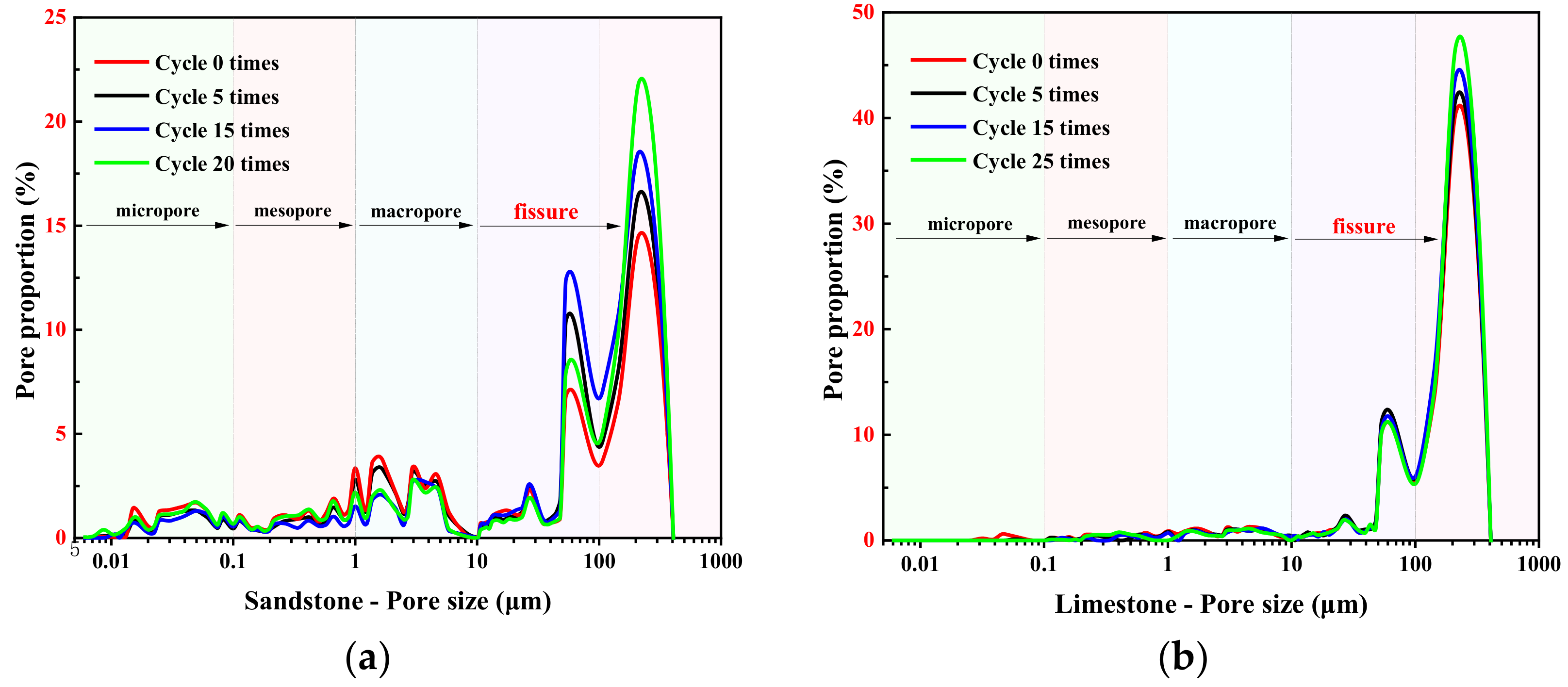
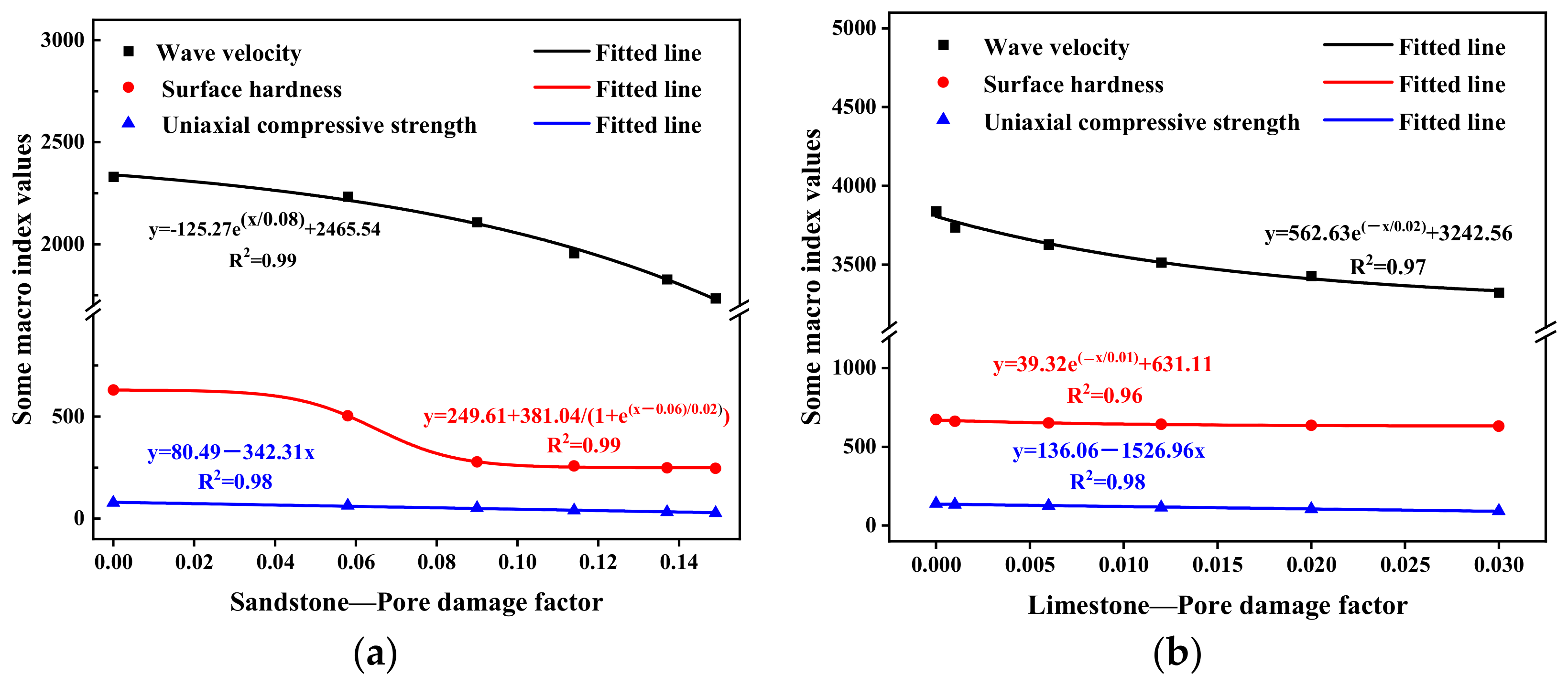
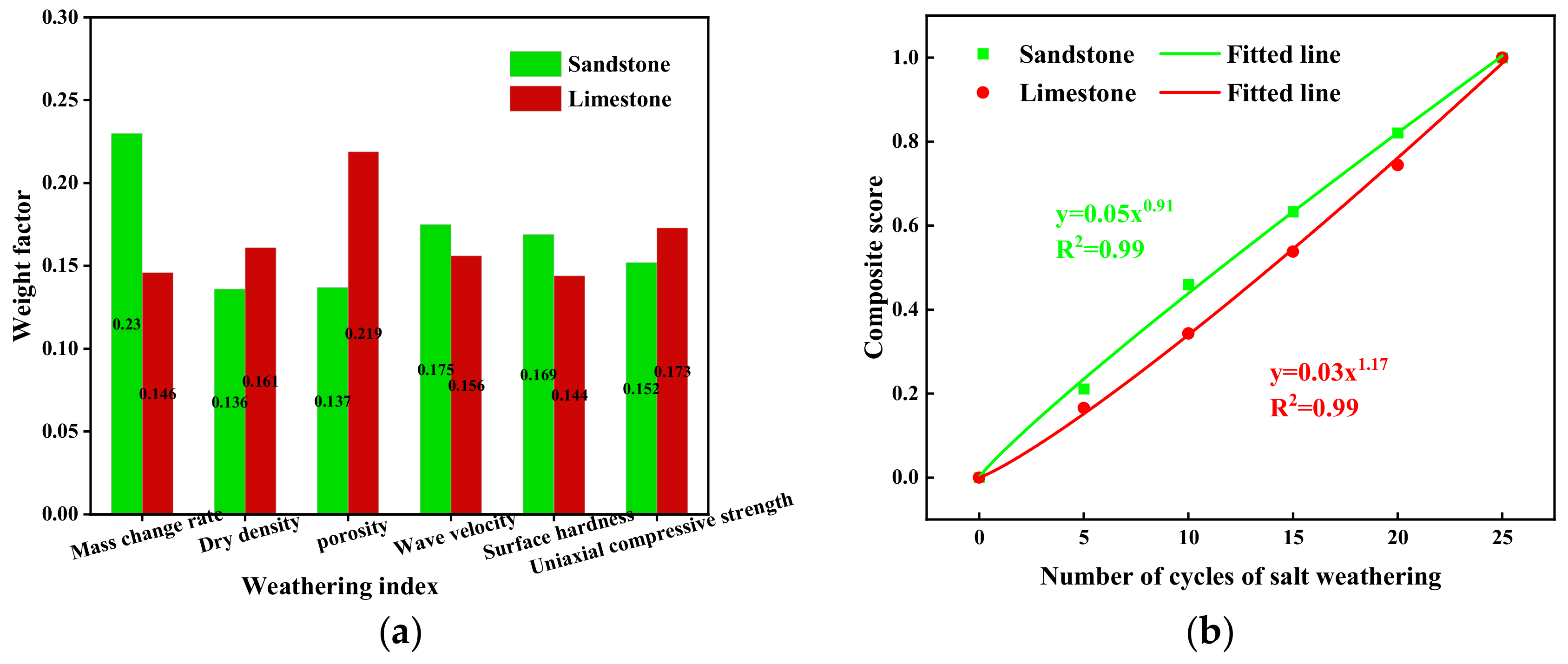
| Rock Type | Dry Density rd/g·cm−3 | Water Absorption ω/% | Total Porosity φ/% | Leeb Hardness R/HL | Wave Velocity ʋ/s·m−1 | Uniaxial Compressive Strength UCS/MPa |
|---|---|---|---|---|---|---|
| Sandstone | ||||||
| Limestone |
| Mineral Composition | Quartz | Albite | Microcline | Calcite | Clay Minerals |
|---|---|---|---|---|---|
| Relative content (%) | 46–55 | 18–25 | 7–12 | 13–19 | 3–7 |
| Cycle Number | Quartz (%) | Albite (%) | Microcline (%) | Calcite (%) | Clay Minerals (%) |
|---|---|---|---|---|---|
| 0 | 46–55 | 18–25 | 8–12 | 15–22 | 5–7 |
| 5 | 52–60 | 16–23 | 7–12 | 15–20 | 6–9 |
| 15 | 58–68 | 12–18 | 6–10 | 12–16 | 7–14 |
| 25 | 65–75 | 7–14 | 3–9 | 7–10 | 10–19 |
Disclaimer/Publisher’s Note: The statements, opinions and data contained in all publications are solely those of the individual author(s) and contributor(s) and not of MDPI and/or the editor(s). MDPI and/or the editor(s) disclaim responsibility for any injury to people or property resulting from any ideas, methods, instructions or products referred to in the content. |
© 2023 by the authors. Licensee MDPI, Basel, Switzerland. This article is an open access article distributed under the terms and conditions of the Creative Commons Attribution (CC BY) license (https://creativecommons.org/licenses/by/4.0/).
Share and Cite
Hong, J.; Zhu, Y.; Zhang, Y.; Huang, J.; Peng, N. Differentiation Study of the Damage Characteristics of Rock Cultural Heritage Sites Due to the Sulfate Weathering Process. Appl. Sci. 2023, 13, 12831. https://doi.org/10.3390/app132312831
Hong J, Zhu Y, Zhang Y, Huang J, Peng N. Differentiation Study of the Damage Characteristics of Rock Cultural Heritage Sites Due to the Sulfate Weathering Process. Applied Sciences. 2023; 13(23):12831. https://doi.org/10.3390/app132312831
Chicago/Turabian StyleHong, Jie, Ye Zhu, Yue Zhang, Jizhong Huang, and Ningbo Peng. 2023. "Differentiation Study of the Damage Characteristics of Rock Cultural Heritage Sites Due to the Sulfate Weathering Process" Applied Sciences 13, no. 23: 12831. https://doi.org/10.3390/app132312831





